Time, in Yupukari as elsewhere, waits on no Manuel.
Manuel the birdman was late and Mike the Rupunadian (which is to say he is both Rupununian and Canadian) was eager to show off the wonders of the Rupununi to some guests. “Well,” said Mike after wondering again about the whereabouts of Manuel, “time waits for no Manuel.”
And off he went.
Time in the Rupununi is different from elsewhere. Sometimes you forget what day it is and occasionally when you ask a villager, they “think” it is one day or the other. Here, in the rolling, grass-covered hills of the Rupununi, sandwiched between the Pakaraima and Kanuku mountain ranges, the day can begin at dusk or dawn depending on your interest.
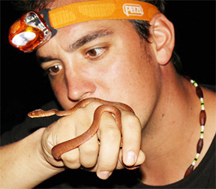
You can go catch an endangered species of caiman in the evenings, feeling the thrill as an 11-foot beast struggles to overpower four experienced guides, then touch and feel the caiman if you are brave enough, or meditate silently for long minutes waiting for shy turtles to trust you and emerge from the placid water of their pond to sun themselves under a cloudless Rupununi sky.
Or you can bird-watch on the savannah or the meandering Rupununi River, go on the Awarikiru Adventure in a dugout canoe paddling past otters and other wildlife on the oxbow lake, or visit another lake where it was thought El Dorado was located. Or you can go into Yupukari village itself and listen to the fascinating stories of Macushi customs in days long past.
You can be an adventurer in Yupukari. A fisherman. An archaeologist exploring the ruins of old forts. You can stand on a hill and look to one side with the knowledge that all the water on that side flows to the Amazon and the water on the other side flows to the Essequibo; one step and you are in the Amazonian watershed, several steps back and you are in the Essequibo watershed. At this point, between these two great basins, you feel not only your place in the universe but also a wonder that you are here.

My destination: Caiman House. Set up by Americans, Alice Layton a social worker and her husband, tropical ecologist Peter Taylor who was studying black caimans in 2005. It is a guest house, a field station, and a hub for many village activities since it also houses the public library and the lone internet access point, while also being the headquarters of Rupununi Learners Incorporated and Yupukari Crafters. Built of local materials, it is powered by solar electricity and has running water and inviting, locally crafted beds with cotton headboards and pebble-top sinks.
Meeting Mike
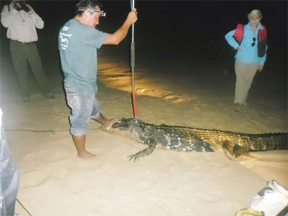
Mike Martin is a towering Rupunadian with an accent which veers to pure Rupununian before bouncing back to Canadian then a smattering of both. An adventurer with a steady smile and a thousand stories, he came to Guyana six years ago, fell in love with the country and a stay intended to be a short one turned into years. “I love it here. Rupununi has heavy gravity. You go, you wanna come back. The lifestyle is great. Fishing and being in the bush has always been something that I did,” he later explained the ‘naa,’ ‘you know’ and ‘aarite’ of the Rupununi naturally rolling out as he spoke of the caiman project and the human-caiman conflict. “A lapsy dog? Wha? Dead!” he exclaimed pointing out that attacks on humans are extremely rare and animals are more likely to be attacked by a caiman. At Caiman House, Mike seemed to be the right hand of most things. He is officially the computer technician working for a small stipend but his range of activities encompasses almost the entire Caiman House and more than anything else, he seems to be a hardworking volunteer.
I arrived at a busy time. Caiman House was preparing to host 11 other guests – a large number for them – and things had to be done. Even so, Mike gave a quick tour of the compound explaining the caimans, the turtles, the pet cats, the purple pepper, the watershed and the research, among other things.
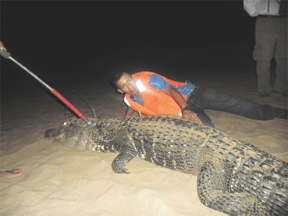
Wandering in the village took most of the day. Toshao Rudolph Roberts explained his plan of transforming the housing of the village from thatched roofs and mud to zinc and burnt clay bricks, a project that most villagers seemed to support with many working on the manufacturing of the bricks. At the village’s lone bar on the outskirts of the community, Neymar the monkey formerly known as Sheiko before a hairstyle change to the ‘pica-pau’ style made famous by the Brazilian footballer Neymar precipitated the name change, greeted visitors. Pica-pau is Portuguese for woodpecker.
At dusk, it was time to seek the Melanosuchus niger – the Amazon’s largest predator.

Melanosuchus niger, the black caiman, is the largest member of the crocodile family. It is endangered but the population at Yupukari is recovering thanks to the caiman monitoring project currently ongoing in the community. While there are no scientists on site at the moment, data collection as part of a long-term project is ongoing, and locals have been trained to capture and take measurements. Guests can observe the capture and assist in data collection as the caimans are weighed, measured, sexed, and tagged.
At dusk, the Rupununi birds – the herons, the storks and all the others – go to rest or come out for the night. Speeding down the smooth water of the meandering Rupununi River, a bat easily keeps pace with the boat as birds swoop and call. Early yet but the stars glitter in the deepening dusk as we meet up with some American tourists, part of the party seeking the Melanosuchus niger that starry night.
“We catch whatever we put our hands on first. If we catch a big one, you will see a lot of banging and biting so don’t feel anyway,” said Rudolph Roberts Jr, the main guide and caiman catcher. Caimans are caught with a wire snare attached to a pole.
“You have all your fingers?” one tourist asked Rudolph.
“All my fingers, all my toes,” he responded.
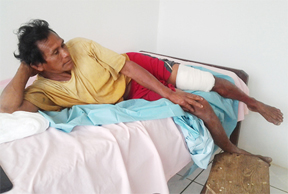
Catching the Melanosuchus niger involves first spotting the reptile. Roaming up and down the river, checking the crevices and cracks and under the branches of overhanging trees with a bright spotlight, what you are looking for is two red eyes glowing in the light. The bright light blinds the caiman which can then be approached and ensnared.
Then begins the battle of strength.
Up the river, down the river, thrashing and splashing, huge jaws snapping, the caiman drags the boat. Line is let out, line is pulled in until the caiman exhausts its strength after about 15 minutes. Then Rudolph, Howard, Marcellus and Manuel work in concert to ensure the snapping jaws are fastened with tape and the caiman is dragged to a sandbank in silence after the epic battle. “They are very aggressive so we tire them out,” Rudolph explains.
Exhausted, it remains immobile and several measurements are quickly taken. The caiman that Monday night is 11 feet four inches long and weighs 346 kilos. Trussed and still, it is a little smaller that the largest one ever tagged at Yupukari which was over 12 feet long.
Under the bright stars that fade rapidly from sight one minute then glitter as brightly as ever in the next few minutes, Rudolph points out the wounds sustained by the caiman, the sensors which can “sense a drop of water ten metres away” and a gland the use of which they haven’t yet figured out. “It’s probably for mating,” he says.
Upturned for more measurements, the Amazon’s largest predator looks no fiercer than a trussed chicken, its underbelly not warm but smooth and cool to the touch.
“This is where all the organs are located,” says Rudolph. “Anybody want to try it?”
“No, thank you,” the two American women quickly respond. “The journalist will try it since he asked about it,” says one of the guides rather too quickly. Earlier, I had asked how they determined whether the caiman is a male or female. It turns out to be a rather simple process once the caiman is immobile. You do not want to try it otherwise.
“This is what you call sexing a caiman,” I ask. “Yes,” said Rudolph.
After the 11 foot Melanosuchus niger is measured, the tag checked, and all is done, the still immobile reptile is dragged back to the waterside and in the most dangerous moment, the jaw bindings are loosened and it is pure human strength that holds it shut. A swing of the extremely hard head can fracture bone. The noose is loosened and it is a quick scamper back to higher ground. After all its thrashing, the caiman is still to regain its strength, but after a few moments, it slowly moves and with a swish it disappears into the dark water.
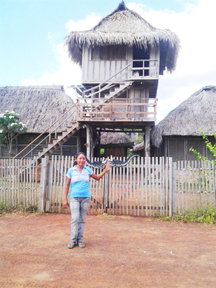
Birds call, something croaks and after more than an hour the catching of the Melanosuchus niger, fierce Amazon predator is done. Back to base, past dozens of little red lights glowing under the spotlight like rubies – the eyes of the caimans shone. The guides stop to catch another baby caiman so I can see and a giant bird flies up in the spotlight and is gone.
At the landing, Mike and his Rupununi accent and the pick-up wait. One of the American tourists and I hop into the back. Turns out they are from New Jersey and read the Stabroek News before deciding to come to Guyana. “What day is today,” he asks as we drive through the night, the cool air coming from the mountain chasing away the scattered clouds to unveil the thousands and thousands of pinpricks of light that are stars.
It is a question that I asked earlier that day. Time is different in the Rupununi.
There is more to Yupukari than the Melanosuchus niger. Make no mistake. While it was relatively safe that night, caimans are dangerous but rarely attack humans though Ivor Antone the next day upset the caiman attack statistics of Yupukari for decades after he stepped on a caiman while fishing and was bitten on the leg. It was a spectacled caiman, which is more aggressive than the black caiman. But it was a rare attack and the first in several decades in the community. Look before you leap.
In Yupukari, roosters crowing awaken you, other birds whistle, screech, caw, sometimes singly, sometimes all in unison, as though fighting to see who can be the loudest or just singing their joy, while turtles allow you to meditate. You can have all the patience in the world waiting for them to emerge from their pond but they have infinitely more patience and only come up for a quick breath of air before quickly dashing down to the depths of the pond. Whoever said that turtles were slow was wrong.
In the morning, the sun breaks through the clouds that shroud the Kanukus bathing the sky in a golden light.
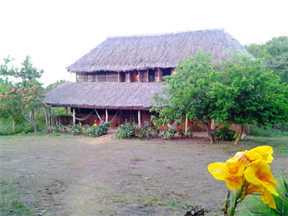
Yupukari is more than just animals but somehow they make great stories. Manuel Mandook of Crested Doradito fame tells of sighting the rare bird and spending days riding miles and miles on horseback seeking the nest. Since it is found in only two areas of Guyana, he said, more experienced guides did not believe that he had found the bird and it was not until he downed one with a slingshot seven months later and showed them the specimen that he was believed. The specimen is now in a museum.
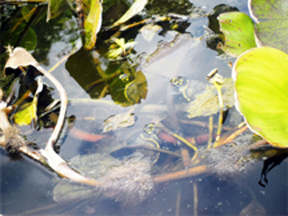
Playing the guitar, listening long into the night to Mike’s fascinating adventures, meeting people with musical names like Delene, Yupukari grows on you and you want to stay longer, go to nearby Karanambu, meet and greet the wild in the pure, pristine savannahs that is slowly changing.
But even in this serene, adventure-filled Macushi community, time waits on no Manuel. Or me.




